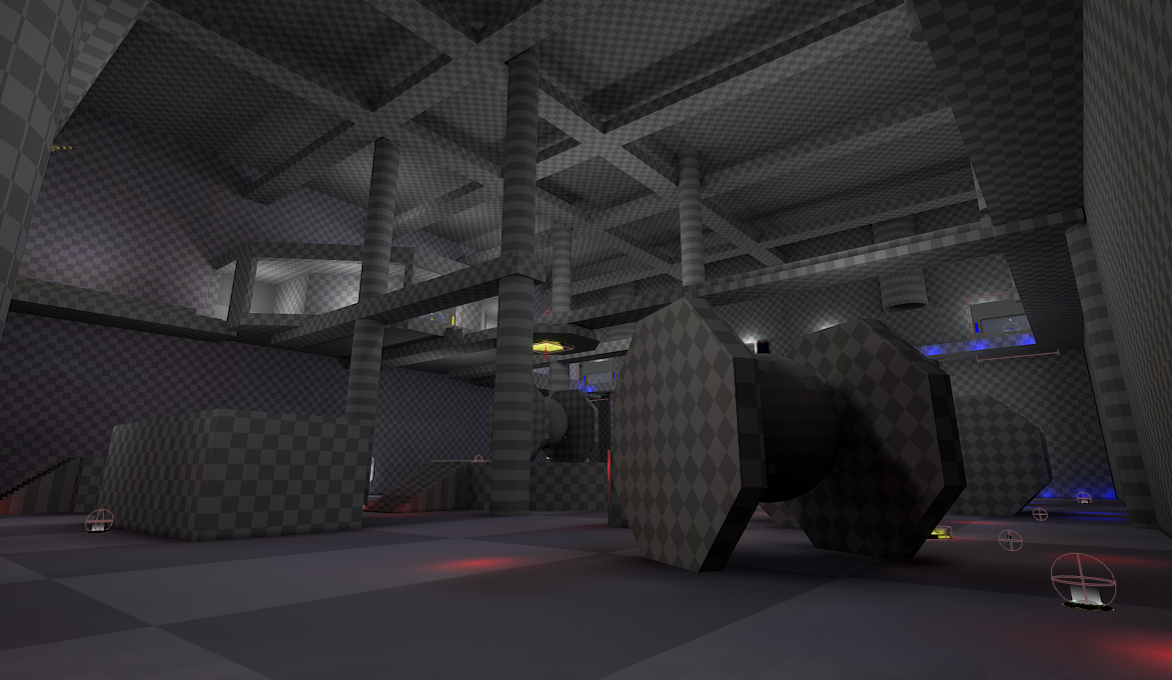
Unreal Engine 4 level: Deck 6
This was a rapid-prototype challenge I posed to myself to refine my understanding of 3D arena spaces from a design perspective by taking a level from paper prototype to the greyboxing stage.
Deck 6 (2020)
Collaboritive?: Solo // Tools: Unreal Engine 4, Adobe Suite, Maya // Timeline: 5 Months
Role(s): Level Designer
An arena-style capture the flag map focused on mobility, sightlines, and varying range gun fights.
Contributions
Documentation: Level maps, paper prototypes, spatial dichotomy diagrams, etc.
Blockout: Used Unreal Engine and Maya to block out the 3D level space.
Game Element Integration: Carefully added and balanced weapon spawns, jump pad locations, and obstacles.
Arena Map Design: Designed, pitched, and prototyped working capture the flag experience from concept to playable experience.
Level Design
The idea for this level came about while playing through a QUAKE campaign which is largely built on movement, and duck-and-cover gameplay. In particular, Quake 3: Team Arena allowed players to pit teams of characters against one another to accomplish an object first using a variety of weapons and mobile strategies. Characters could dash, jump, dodge, rocket jump, bounce, and bunny hop as needed to get around the map.
Many maps in Unreal Tournament already had plenty of maps focusing on adventure, scenic shots, high-intensity combat, and more styles of gameplay, but few seemed to capitalize on the physics and movement controllers available to players already. Launch pads for instance typically were used to move players from one point to another in linear fashion with little room for interpretation. In “Deck 6”, I aimed to allow these jump pads to guide players between two points, but allow for players to wander between these points while in use, such as as the jump pads.
This was the first layout I planned using a rough spatial map by pen and paper to get a feel for what I wanted the space to look like. It also helped me identify issues with flow, sights, accessibility, etc. early on outside of digital tools. For instance, I used this plan as evidence to add a back chute on the north end of the map, more coverage in the center north and center south spaces, and add jump pads near each flag room. This saved hours of design and revision work in digital tools later on.
“Deck 6” went under a couple major iterations to ensure it met its core goal: to champion movement controls in an arena-style game mode. One such iteration is pictured below. It was the first draft I created before entering digital tools and refining my ideas further.
Testing within the Engine
As I found useful in my prior levels I’ve created, I spent very little time on detailing the first and second drafts to this level; this was a rapid prototyping/greyboxing challenge which meant my time was limited to working on this project. Because of this, I brought the map into the Unreal Engine as quickly as I could, and realized the map was lacking a second floor it desperately needed as it was to function as a hangar, not a regular room. Taking inspiration from Star Wars’ Death Star designs, I drafted the second floor in-engine. This is also where I got the idea for the crane featured in the center of the map. It was a great way to tie both the thematic and functional elements together; players could run across it while seeing what its thematic purpose would be—to move TIE fighters across the map. If I had more time, my next goal would have been to animate this crane to physically lift and move the fighter on display underneath it.
Above: the map’s TIE fighter and crane, which players can run across the top of, and view from nearly anywhere on the map.
The Result
While the level turned out quite well, there were some issues I noticed with the design of the space going forward.
For instance, the top ring which encircles the map provides excellent sniper coverage across the map with little to no way to challenge snipers other than sniping those snipers with provided weapons. Blocking the line of sight would either interrupt existing jump pad lines, environment vision paths, or existing aesthetic elements. It also would beg the question why sniper rifles were in the map if the map lacked a sniping area. This is a challenge I am still investigating currently.
Deck 6 posed an interesting challenge of prototyping a 3D level in the Unreal Engine as quickly as possible. There are inherent issues with the design which would normally be resolved through playtesting (as PolarBase did so through development). Instead, I use this map highlight the importance of process and rapid prototyping.






